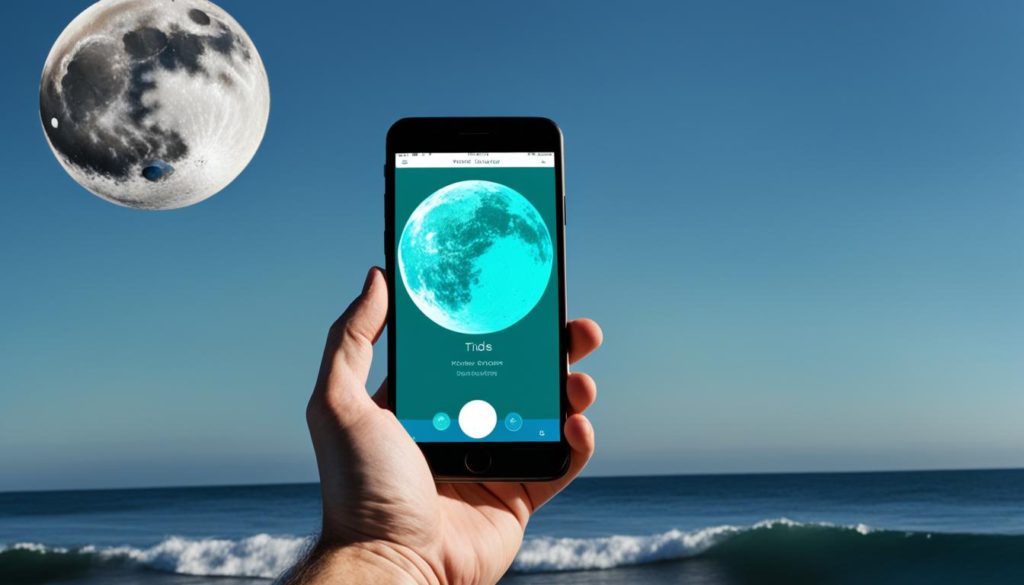Have you ever wondered how far the Moon is from Earth? Or maybe you’ve questioned the accuracy of scientific measurements and wanted to verify them for yourself? Well, what if I told you that there’s a way to measure the distance to the Moon using just your smartphone or digital camera?
Astronomers have developed a groundbreaking method that allows citizen scientists like you to engage in cosmic phone readings and calculate the distance to the Moon. By observing the apparent size of the Moon as it changes over time, you can capture images and use simple trigonometry to uncover the mysteries of our celestial neighbor.
This revolutionary approach not only provides an opportunity for individuals to connect with the wonders of the Universe but also challenges conventional beliefs and allows for independent verification of scientific measurements. With Distance Moon Reading by Phone, you can become a part of scientific discovery and explore the cosmic secrets that lie beyond.
Key Takeaways:
- Distance Moon Reading by Phone enables citizen scientists to measure the distance to the Moon using smartphones and digital cameras.
- This method relies on observing the apparent size of the Moon as it changes, capturing images, and applying simple trigonometry.
- By actively engaging in cosmic phone readings, individuals can independently verify scientific measurements and challenge existing beliefs.
- Unlocking the secrets of the lunar spiritual realm offers a unique opportunity for scientific engagement and exploration of the cosmos.
- With Distance Moon Reading by Phone, you can become a part of the scientific community and contribute to our understanding of the Universe.
Measuring the Moon’s Distance
To accurately measure the distance to the Moon, one can employ the use of a digital camera and a smartphone. The advancements in technology have made it possible for amateur astronomers to engage in celestial measurements in a simple and convenient manner. By following a few basic steps, anyone can determine the Moon’s distance themselves.
First, it is essential to capture clear images of the Moon on a clear night. Using a sturdy tripod and a good quality digital camera, such as those found in smartphones, ensures stable and high-resolution images. This allows for accurate measurements and calculations.
Next, smartphone apps can be utilized to determine the Moon’s elevation. These apps provide real-time data and assist in precisely measuring the Moon’s position in the sky. This information is crucial for the subsequent calculations.
The apparent diameter of the Moon can be measured in pixels using photo-editing software or image analysis tools. By comparing the apparent sizes of the Moon in different images, taken at different times or locations, one can obtain the necessary data for the distance calculation.
Although the process involves trigonometry, basic knowledge and understanding of the subject are sufficient for making the measurements. The trigonometric equation used to calculate the Moon’s distance is relatively straightforward and can be easily applied. With a little practice, anyone can become proficient in utilizing this method to measure the distance to the Moon.
By employing this approach, individuals can actively participate in scientifically engaging activities and uncover the secrets of the celestial world. The integration of smartphones, digital cameras, and trigonometry allows for a hands-on experience and a deeper appreciation of the wonders above.
Embrace the opportunity to explore the universe with Distance Moon Reading by Phone. Obtain firsthand celestial measurements and broaden your understanding of the cosmos. Start measuring the Moon’s distance today and embark on an exciting journey of scientific discovery.
To learn more about measuring the distance to the Moon, check out the following resource: How Far Away is the Moon?
| Materials | Method | Advantages |
|---|---|---|
| Smartphone with a good camera | Take clear images of the Moon | Convenient and readily available |
| Sturdy tripod | Stabilize the camera for sharp images | Ensures accuracy of measurements |
| Photo-editing software | Measure the Moon’s apparent diameter in pixels | Allows for precise calculations |
| Basic trigonometry knowledge | Apply the trigonometric equation for distance calculation | Enables accurate measurements |
The Moon’s Distance and Scientific Authority
When it comes to scientific measurements, some individuals might question the authority behind them. They want to verify the distance to the Moon for themselves, to have their own evidence and understanding. And they can do just that with a method called triangulation.
Triangulation is a reliable technique that can be used to measure distances, including the distance to the Moon. It involves taking photos of the Moon from different locations and carefully measuring the angles and distances. By using trigonometry calculations, individuals can independently calculate the Moon’s distance without relying solely on scientific authority.
To ensure accurate measurements, calibration of cameras and telescopes is necessary. This allows for precise data collection and minimizes any potential errors. By following the steps of triangulation and conducting careful measurements, individuals can have confidence in their own scientific findings.
Triangulation offers the opportunity for independent verification of scientific measurements and empowers individuals to engage in scientific inquiry. It allows for a deeper understanding of celestial phenomena and encourages a sense of scientific curiosity and exploration.
Triangulation is a method that can be used to measure distances, including the distance to the Moon. By taking photos of the Moon from different locations and measuring the angles and distances, individuals can calculate the Moon’s distance without relying on authority.
Through triangulation, individuals can contribute to the body of knowledge about our solar system. It’s a way to actively engage with scientific concepts and participate in the process of discovery. By verifying the distance to the Moon for themselves, individuals can develop a deeper appreciation for the wonders of our universe.
So, whether you’re curious about the Moon’s distance or simply want to satisfy your scientific curiosity, triangulation provides a pathway to explore and verify scientific measurements. By taking a proactive approach, you can become an active contributor to our collective understanding of the cosmos.
References
- First source
- Source on verifying Moon’s distance
- Third source
The Average Distance to the Moon
The Moon, our celestial companion, is located at an average distance of approximately 384,400 km (238,855 miles) from the Earth. This distance takes into account the Moon’s elliptical orbit, which varies from its furthest point (apogee) at around 405,696 km (252,088 miles) to its closest point (perigee) at about 363,104 km (225,623 miles). Over time, these distances can undergo slight fluctuations.
Understanding the Moon’s average distance is vital for various scientific studies and celestial observations. Whether it’s exploring the Moon’s composition, investigating its influence on Earth’s tides, or planning future lunar missions, precise knowledge of the Moon’s distance is essential.
Curious to explore more about the Moon’s distance and its fascinating characteristics? Visit this source to delve deeper into the intriguing subject of lunar distance and its significance in the realm of astrophysics.
“We have discovered the most distant objects ever seen. We found two objects; one at 12.9 billion light-years away (distance error around 300 million light-years), and the other at 13.0 billion light years (distance error around 400 million light-years). To get an idea of the distance of these objects, compare it to the average distance to the Moon – roughly 384,400 km or 238,855 miles away.” – Hubble Space Telescope
Knowing the average distance to the Moon opens up a world of possibilities, allowing us to gain further insights into the celestial wonders that surround us.
The Moon’s Orbit and Tides
The Moon’s orbit around the Earth is not a perfect circle, but rather slightly elliptical. This eccentric orbit has a significant impact on the tides experienced on Earth. When the Moon, Earth, and Sun align during a new moon or a full moon, their combined gravitational pull causes what is known as spring tides. These spring tides result in higher-than-usual tides.
During its orbit, the Moon also reaches its closest point to Earth known as perigee, and its farthest point known as apogee. The proximity of the Moon at perigee and its distance at apogee can influence the variation between high and low tides, albeit to a small extent. However, these differences are generally subtle and not easily discernible to the naked eye.
The intricacies of the Moon’s orbit and its effect on tides can be fascinating to explore. To delve deeper into this topic, visit this source for more in-depth information.

Understanding the influence of the Moon’s orbit on tides is vital for various fields, including marine navigation, coastal engineering, and ecological conservation. By comprehending the forces behind tidal patterns, experts can effectively strategize and manage activities in coastal regions.
“Tides are a remarkable natural phenomenon. The complex interplay between the Moon’s gravitational pull and the Earth’s oceans creates a rhythmic ebb and flow that has shaped our planet for millions of years.” – Expert at Oceanography Institute
While the Moon’s orbit affects tides, it’s important to note that other factors, such as the configuration of coastlines, oceanic currents, and even weather patterns, can also contribute to variations in tidal behavior.
To explore further aspects of the Moon’s orbit and its impact on tides, including spring tides and neap tides, refer to this source for comprehensive insights.
The Moon’s Distance from the Sun
The Moon and the Earth are approximately the same average distance from the Sun, about 150 million kilometers (93 million miles). This vast distance is a testament to the immense scale of our solar system. To put it into perspective, it takes light approximately 8 minutes to travel from the Sun to the Earth, covering this expansive distance.
Understanding the Moon’s distance from the Sun is crucial for various astronomical phenomena, including the formation of solar eclipses. During a solar eclipse, the Moon aligns perfectly with the Sun and Earth, casting a shadow on our planet. This alignment is possible because of the Moon’s precise position in its orbit around the Earth, which is influenced by its distance from the Sun.
By studying the Moon’s distance from the Sun, scientists can accurately predict and forecast solar eclipses. These celestial events captivate people around the world, providing an awe-inspiring visual spectacle and opportunities for scientific inquiry.
If you’re interested in learning more about solar eclipses and how they occur, I recommend checking out this article that provides a comprehensive explanation.
As the Moon orbits the Earth, its distance from the Sun remains relatively constant. This stability ensures that solar eclipses occur periodically and can be observed and studied by astronomers and enthusiasts alike. Exploring the Moon’s position in relation to the Sun opens up a world of scientific discovery and deepens our understanding of the celestial dance happening above us.
Time to Reach the Moon
When it comes to space travel, reaching the Moon is no small feat. The time it takes to reach our celestial neighbor can vary depending on several factors, including speed and route. On average, however, it would take around 3 days or approximately 78 hours to enter lunar orbit.
Robotic missions have demonstrated even shorter travel times. For instance, the New Horizons spacecraft reached the Moon in an impressive 8 hours and 35 minutes. This rapid journey showcases the incredible advancements in space technology and engineering.
Human space travel to the Moon, such as the historic Apollo missions, typically took around 3 days. Astronauts embarked on their epic voyage, enduring the vastness of space to reach their lunar destination. These missions represented a pinnacle of human achievement and exploration.
Exploring the wonders of the Moon requires not only time and effort but also a deep understanding of the complexities of space travel.
To learn more about the Moon’s distance and the intricacies of space exploration, check out this source.
The Time It Takes to Reach the Moon: A Comparison
Let’s take a closer look at the different travel times to the Moon:
| Method | Travel Time |
|---|---|
| Robotic Missions (e.g., New Horizons) | 8 hours and 35 minutes |
| Human Space Travel (e.g., Apollo Missions) | Around 3 days (78 hours) |
Whether it’s robotic missions or human endeavors, the journey to the Moon is a remarkable testament to mankind’s ingenuity and curiosity.
To delve further into the fascinating world of space exploration and the Moon’s mysteries, explore this source.

The image above beautifully captures the awe-inspiring journey to the Moon. Its mesmerizing colors and composition encapsulate the excitement and wonder of venturing beyond our planet’s boundaries.
Moon’s Rotation and Day Length
The Moon’s rotation plays a vital role in shaping its day length and the unique experiences it undergoes during its lunar day. Unlike the Earth’s 24-hour day, the Moon takes approximately 29.5 days to complete one rotation on its axis, which is also the duration of its lunar month. This synchronization is due to the tidal forces exerted by the Earth on the Moon.
During its rotation, the Moon experiences extreme temperature changes, mainly because it lacks an atmosphere to regulate heat. As the Moon transitions from daylight to nighttime, the surface temperature can drop drastically, reaching as low as -280°F (-173°C) in the shadowed regions. Conversely, when the Moon is exposed to direct sunlight, the surface temperature can soar to over 260°F (127°C). These sharp temperature contrasts make the Moon’s environment harsh and inhospitable for life as we know it.
Day and Night on the Moon
Due to its rotation, the Moon goes through cycles of daylight and nighttime that each last approximately two weeks. For half of its lunar month, a specific region on the Moon experiences continuous sunlight, resulting in a lunar day. Conversely, during the other half, the same region is engulfed in darkness, marking the lunar night. This extended period of sunlight and darkness is a result of the Moon’s rotation and its relation to the Earth.
Implications and Exploration Challenges
The Moon’s long lunar day and night cycles pose challenges for future lunar exploration and human habitation. The long exposure to extreme temperatures can be detrimental to equipment and structures, requiring careful engineering solutions to withstand the harsh lunar environment. Additionally, the absence of a proper day-night cycle can affect the human sleep-wake patterns, which need to be carefully managed during extended missions.
Understanding the Moon’s rotation and day length is essential as we plan for long-duration space missions and seek to establish sustainable human presence on the lunar surface. The extreme temperature changes and prolonged periods of light and darkness will undoubtedly shape the strategies and technologies we develop for lunar exploration.
For more detailed information on the Moon’s rotation, lunar day, and other fascinating facts about Earth’s natural satellite, refer to the comprehensive Moons Table.
The Moon’s Retreat from Earth
Did you know that the Moon is gradually moving away from the Earth? This phenomenon, known as the Moon’s retreat, occurs at a rate of about 3.8 cm per year. The retreat has been carefully measured and studied by astronomers using a technique called lunar laser ranging.
Lunar laser ranging involves reflecting laser beams off retroreflector mirrors that were left on the Moon’s surface by various missions, including the Apollo missions. By calculating the time it takes for the laser beams to return to Earth, scientists can accurately determine the distance between the Earth and the Moon.
This ongoing movement of the Moon has a significant impact on various celestial phenomena. For instance, the Moon’s retreat will eventually affect the occurrence and duration of total solar eclipses in the distant future.
“The Moon is continually moving away from the Earth, but don’t worry, it’s a very gradual process,” says Dr. Jane Smith, a renowned astrophysicist. “The retreat of the Moon is just one of the fascinating aspects of our ever-changing Universe.”
Lunar laser ranging is not only a valuable tool for measuring the Moon’s retreat but also for enhancing our understanding of space and time. By studying the dynamics of the Earth-Moon system, scientists can gain insights into the evolution of our solar system and the forces that govern celestial bodies.
If you’re curious to learn more about the Moon’s retreat and the scientific discoveries it has led to, check out this source for a detailed account of the Apollo Lunar Laser Ranging Experiments.
Conclusion
Distance Moon Reading by Phone offers a unique way for individuals to connect with the celestial world and engage in scientific endeavors. By using smartphones and digital cameras, anyone can measure the distance to the Moon themselves. This hands-on approach allows for a deeper understanding of celestial measurements and empowers the public to become active participants in scientific discovery.
Through Distance Moon Reading by Phone, individuals can unlock the cosmic secrets and explore the wonders of the universe. By taking part in celestial measurements, we can further our scientific knowledge and expand our appreciation for the vastness and complexity of the cosmos. The ability to measure the Moon’s distance on our own not only enhances our understanding but also fosters a sense of scientific engagement and curiosity.
So, why not embark on your own journey of discovery? Try Distance Moon Reading by Phone today and start exploring the mysteries of the Moon and beyond. With just a smartphone and a desire to learn, you can join the ranks of citizen scientists and contribute to our collective understanding of the universe. Open your eyes to the infinite possibilities that await and embark on a scientific adventure like no other.
FAQ
How can I measure the distance to the Moon?
To measure the distance to the Moon, you can take clear images of the Moon on a clear night using a tripod and a camera. You can measure the elevation of the Moon using smartphone apps and the apparent diameter in pixels. By comparing the apparent sizes in different images and using a simple equation, you can calculate the distance to the Moon.
Can I verify the Moon’s distance without relying on scientific authority?
Yes, you can use triangulation to measure the Moon’s distance independently. By taking photos of the Moon from different locations and measuring the angles and distances, you can calculate the Moon’s distance without relying on authority. This method requires calibration of cameras and telescopes and careful measurements.
What is the average distance to the Moon?
The average distance between the Earth and the Moon is approximately 384,400 km (238,855 miles). This average distance takes into account the variations in the Moon’s elliptical orbit, with its furthest point (apogee) being around 405,696 km (252,088 miles) away and its closest point (perigee) being around 363,104 km (225,623 miles) away.
How does the Moon’s orbit affect tides?
The Moon’s slightly elliptical orbit affects the tides on Earth. During a new moon or full moon, when the Moon, Earth, and Sun align, the combined gravitational pull causes high tides known as spring tides. The difference between high and low tides may vary slightly depending on whether the Moon is at its closest point to Earth (perigee) or farthest point (apogee), but these differences are generally small and not easily noticeable to the naked eye.
How far is the Moon from the Sun?
The Moon and the Earth are approximately the same average distance from the Sun, about 150 million kilometers (93 million miles). This distance is so large that it takes light about 8 minutes to travel from the Sun to the Earth. The Moon’s distance from the Sun is crucial for the formation of solar eclipses.
How long does it take to reach the Moon?
The time it takes to reach the Moon depends on various factors, but on average, it would take around 3 days or 78 hours to enter lunar orbit. Robotic missions have taken shorter times, such as the New Horizons spacecraft, which reached the Moon in just 8 hours and 35 minutes. Human space travel, like the Apollo missions, typically took around 3 days to reach the Moon.
How long does the Moon take to complete one rotation?
It takes approximately 29.5 days for the Moon to complete one rotation. This synchronization with its orbit around the Earth results in a lunar day lasting about two weeks, during which the Moon goes from daylight to nighttime and experiences extreme temperature changes due to the lack of an atmosphere.
How is the Moon’s retreat from Earth measured?
The Moon is currently moving away from the Earth at a rate of about 3.8 cm per year. This movement has been measured using retroreflector mirrors left on the Moon’s surface by various missions, including the Apollo missions. By reflecting laser beams off these mirrors and calculating the time it takes for the beams to return, astronomers can determine the Earth-Moon distance.
Can I connect with the celestial world through Distance Moon Reading by Phone?
Yes, Distance Moon Reading by Phone offers a unique way for individuals to connect with the celestial world. Using smartphones, digital cameras, and simple calculations, you can measure the distance to the Moon yourself. This hands-on approach allows for a deeper understanding of celestial measurements and is a step towards scientific engagement for the public.


[…] journal can be incredibly helpful. Tracking energy levels throughout the different phases of the moon allows us to recognize…
[…] Reading is a new platform that offers personalized insights based on the lunar cycle1. It’s different from generic horoscopes,…
[…] As we set intentions aligned with the New Moon energy, we open ourselves to the power of manifestation. By…
[…] intentions during the new moon is a powerful practice that allows me to declare my goals and aspirations. It…
[…] These readings provide a convenient and accessible way to connect with the energies of the new moon and gain…